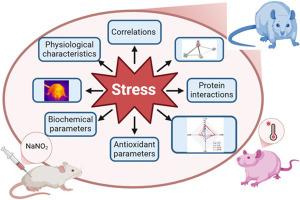Stability vector of blood biochemical and antioxidant parameters in the interaction of nitrate poisoning and heat stress
IF 8.1
2区 环境科学与生态学
Q1 ENVIRONMENTAL SCIENCES
引用次数: 0
Abstract
Heat stress and nitrite/nitrate poisoning have a complex and in some respects similar effect on the body, due to their ability to cause hypoxia. Studying their complex effects is critical to understanding their impact on the body in the context of modern environmental. The study compared the effect of heat stress, sodium nitrite () alone and their combined effect on the body of rats. It was found that the combined effect of heat stress and nitrite poisoning leads to more significant imbalances in the body of rats, which manifest themselves in the form of hypoxia, oxidative stress and changes in biochemical parameters. Pronounced changes were observed in the group of animals exposed to simultaneous sodium nitrite and heat stress, indicating their synergistic effect. These changes include: a decrease in blood oxygenation to 80 % before death (compared to 99.1 % in control at 19 °C), a reduction in life expectancy after administration to 7.2 min (compared to 12.1 min at 19 °C and the same dose of ), changes in heart rate and body temperature indicating impaired circulation and thermoregulation. Significant antioxidant and biochemical changes were observed in the groups exposed to combined stress and a significant increase in cholesterol levels (∼11 times). The analysis of protein interactions showed that Hif1a is a key regulator of adaptive responses, which coordinates the stress response through interaction with proteins of different functional clusters.

硝酸盐中毒与热应激交互作用中血液生化及抗氧化参数的稳定性载体
热应激和亚硝酸盐/硝酸盐中毒对身体的影响复杂,在某些方面相似,因为它们都能引起缺氧。研究它们的复杂影响对于理解它们在现代环境下对身体的影响至关重要。本研究比较了热应激、亚硝酸钠(NaNO2)单独及两者联合对大鼠机体的影响。研究发现,热应激和亚硝酸盐中毒的共同作用导致大鼠体内的失衡更为显著,表现为缺氧、氧化应激和生化参数的变化。在同时暴露于亚硝酸钠和热应激的动物组中观察到明显的变化,表明它们的协同作用。这些变化包括:死亡前血氧合降低至80%(与19°C对照组的99.1%相比),NaNO2给药后预期寿命降低至7.2分钟(与19°C和相同剂量的NaNO2相比为12.1分钟),心率和体温变化表明循环和体温调节受损。在暴露于联合应激和胆固醇水平显著增加(~ 11倍)的组中,观察到显著的抗氧化和生化变化。蛋白质相互作用分析表明,Hif1a是适应性反应的关键调控因子,通过与不同功能簇的蛋白质相互作用来协调应激反应。
本文章由计算机程序翻译,如有差异,请以英文原文为准。
求助全文
约1分钟内获得全文
求助全文
来源期刊

Chemosphere
环境科学-环境科学
CiteScore
15.80
自引率
8.00%
发文量
4975
审稿时长
3.4 months
期刊介绍:
Chemosphere, being an international multidisciplinary journal, is dedicated to publishing original communications and review articles on chemicals in the environment. The scope covers a wide range of topics, including the identification, quantification, behavior, fate, toxicology, treatment, and remediation of chemicals in the bio-, hydro-, litho-, and atmosphere, ensuring the broad dissemination of research in this field.
 求助内容:
求助内容: 应助结果提醒方式:
应助结果提醒方式:


